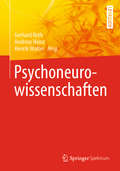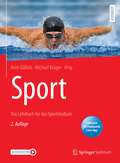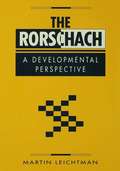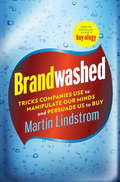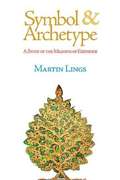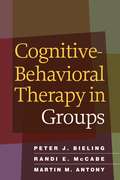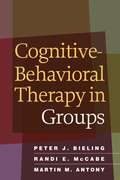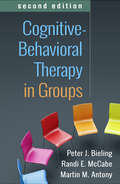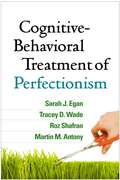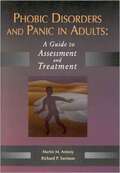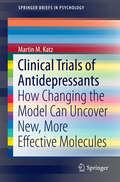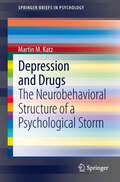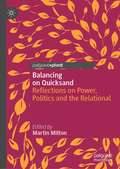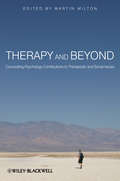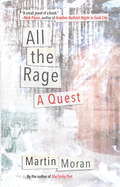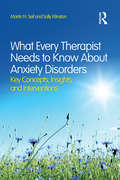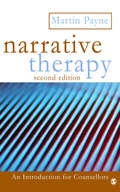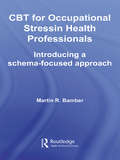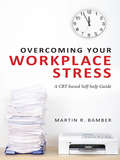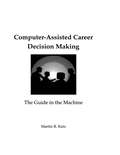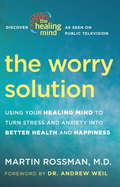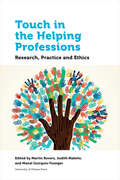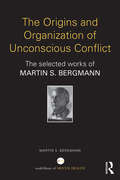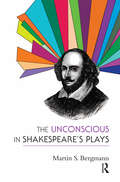- Table View
- List View
Psychoneurowissenschaften
by Martin LayDas Lehrbuch schlägt eine Brücke zwischen den „Neurowissenschaften“ (theoretische und experimentelle Neurobiologie, Neurologie) und den „Psychowissenschaften“ (Psychologie, Psychiatrie, Psychotherapie) und will dabei helfen, den jeweils anderen Disziplinen die wichtigsten und wissenschaftlich gesicherten Kenntnisse in verständlicher Form zu liefern. Die Frage, wie sich psychisches Erleben und Gehirnvorgänge zueinander verhalten, galt lange als rätselhaft. In diesem Buch erfahren Sie aufgrund neuester wissenschaftlicher Erkenntnisse, dass beide Bereiche eine unauflösliche Einheit bilden, auch wenn wir sie unterschiedlich erfahren und untersuchen. Diese Einheit stellen wir in der psychologisch-neurobiologischen Theorie und der psychiatrisch-psychotherapeutischen Praxis konkret dar. Wir behandeln die Prinzipien der neurobiologischen Erregungs- und Informationsverarbeitung, Aufbau und Funktion des limbischen Systems, die Entwicklung der Persönlichkeit und der dabei stattfindenden günstig oder ungünstig verlaufenden Interaktion genetisch-epigenetischer Faktoren und vorgeburtlich sowie nachgeburtlich stattfindender Umwelteinflüssen. Auf dieser Grundlage erfolgt die beispielhafte Darstellung wichtiger psychischer Störungen wie Suchterkrankungen, schizophrene Störungen, affektive Störungen sowie Angststörungen. In der Nachfolge des bedeutenden Psychotherapeuten Klaus Grawe wird schließlich in das, Konzept der „Neuropsychotherapie“ eingeführt und gezeigt, warum Psychotherapie und Neurobiologie zusammengehören, und sich gegenseitig bereichern können. Unser psychoneurowissenschaftlicher Ansatz zeichnet ein Menschenbild, das nicht auf Gegensätzen, sondern einer Integration von Psyche, Gehirn, Verhalten und Erleben beruht.
Sport: Das Lehrbuch für das Sportstudium
by Martin LayDie vollständig überarbeite Neuauflage des Lehrbuchklassikers knüpft an das bewährte Konzept der Erstauflage an und umfasst alle wesentlichen Themenfelder und Inhaltsbereiche für ein erfolgreiches Sportstudium. Abseits einer grundlegenden Aktualisierung zeichnet sich die Folgeauflage insbesondere durch eine Vielzahl an digitalen Zusatzmaterialien aus. Für Studierende wird somit eine innovative Möglichkeit zur multimedialen Wissensvermittlung geschaffen, die weit über das geschriebene Buch hinausgeht. In diesem Lehrbuch erfahren Sie die aktuellen Erkenntnisse zu den vielfältigen Facetten des modernen Sports: Vom Schulsport über den Freizeit-, Breiten-, Fitness- und Gesundheitssport bis hin zum Wettkampf- und Spitzensport. Renommierte Expertinnen und Experten der Trainingswissenschaft, Medizin, Sozialwissenschaften und Pädagogik erklären die aktuelle Theorie und Praxis des Sports speziell für Ihr Sportstudium.Herausragende Merkmale sind:Verständliche Erklärungen von Fachkräften mit ausgiebiger PraxiserfahrungHervorhebung des Wichtigsten in prägnanten MerksätzenZahlreiche praktische Beispiele, Verbindung von Theorie und PraxisAnschauliche Darstellung mit ca. 400 farbigen Bildern und GrafikenUmfangreiches Glossar zum Nachschlagen von DefinitionenDigitale Übungsfragen zur Lernkontrolle und PrüfungsvorbereitungAbrufbare Videos für eine multimediale WissensvermittlungDas Lehrbuch Sport konzentriert sich auf die Inhalte der Bachelorstudiengänge mit Sportbezug. Nahezu alle Module des Bachelorstudiums finden sich in den Kapiteln wieder. Zusätzlich bietet es zentrale Grundlagen für die verschiedenen Sport-Masterstudiengänge, Fort- und Weiterbildungen von Sportlehrkräften und Sportfachpersonal in den vielfältigen Berufsfeldern sowie für den Leistungskurs Sport.
The Rorschach: A Developmental Perspective
by Martin LeichtmanMartin Leichtman's The Rorschach is a work of stunning originality that takes as its point of departure a circumstance that has long confounded Rorschach examiners. Attempts to use the Rorschach with young children yield results that are inconsistent if not comical. What, after all, does one make of a protocol when the child treats a card like a frisbee or confidently detects "piadigats" and "red foombas"? A far more consequential problem facing examiners of adults and children alike concerns the very nature of the Rorschach test. Despite voluminous literature establishing the personality correlates of particular Rorschach scores, neither Hermann Rorschach nor his intellectual descendants have provided an adequate explanation of precisely what the subject is being asked to do. Is the Rorschach a test of imagination? Of perception? Of projection? In point of fact, Leichtman argues, the two problems are intimately related. To appreciate the stages through which children gradually master the Rorschach in its standard form is to discover the nature of the test itself. Integrating his developmental analysis with an illuminating discussion of the extensive literature on test administration, scoring, and interpretation, Leichtman arrives at a new understanding of the Rorschach as a test of representation and creativity. This finding, in turn, leads to an intriguing reconceptualization of all projective tests that clarifies their relationships to more objective measures of ability.
Brandwashed: Tricks Companies Use to Manipulate Our Minds and Persuade Us to Buy
by Martin LindstromForeword by Morgan SpurlockFrom the bestselling author of Buyology comes a shocking insider's look at how today's global giants conspire to obscure the truth and manipulate our minds, all in service of persuading us to buy. Marketing visionary Martin Lindstrom has been on the front lines of the branding wars for over twenty years. Here, he turns the spotlight on his own industry, drawing on all he has witnessed behind closed doors, exposing for the first time the full extent of the psychological tricks and traps that companies devise to win our hard-earned dollars. Picking up from where Vance Packard's bestselling classic, The Hidden Persuaders, left off more than half-a-century ago, Lindstrom reveals: * New findings that reveal how advertisers and marketers intentionally target children at an alarmingly young age - starting when they are still in the womb! * Shocking results of an fMRI study which uncovered what heterosexual men really think about when they see sexually provocative advertising (hint: it isn't their girlfriends). * How marketers and retailers stoke the flames of public panic and capitalize on paranoia over global contagions, extreme weather events, and food contamination scares. * The first ever neuroscientific evidence proving how addicted we all are to our iPhones and our Blackberry's (and the shocking reality of cell phone addiction - it can be harder to shake than addictions to drugs and alcohol). * How companies of all stripes are secretly mining our digital footprints to uncover some of the most intimate details of our private lives, then using that information to target us with ads and offers 'perfectly tailored' to our psychological profiles. * How certain companies, like the maker of one popular lip balm, purposely adjust their formulas in order to make their products chemically addictive. * What a 3-month long guerilla marketing experiment, conducted specifically for this book, tells us about the most powerful hidden persuader of them all. * And much, much more. This searing expose introduces a new class of tricks, techniques, and seductions - the Hidden Persuaders of the 21st century- and shows why they are more insidious and pervasive than ever. From the Hardcover edition.
Symbol and Archetype: A Study of the Meaning of Existence
by Martin LingsEvery religious tradition or metaphysical worldview involves a system of powerful symbols, most of which bear common meanings across cultures, continents, and time. This volume, complete with a 9th century Quranic manuscript, explores the significance of the most recurrent symbols and archetypes in human history and elaborates a compelling theory for why symbolism plays such an essential role in human life. The work explores certain basic aspects of symbolism in relation to the Divinity, the hierarchy of the universe, the function of human faculties and qualities, the human condition, natural objects, works of art, and the final end--all with reference to the great living religions of the world, and in particular to Christianity and Islam.
Cognitive-Behavioral Therapy in Groups
by Peter J. Bieling Martin M. Antony Randi E. MccabeAn authoritative practitioner guide and student text, this book offers clear advice on how to structure and lead cognitive-behavioral therapy (CBT) groups and overcome common challenges that arise. Specific, evidence-based group assessment and treatment protocols are provided for a range of frequently encountered disorders. Emphasizing that a CBT group is more than the sum of its individual members, the authors show how to understand and use group process to optimize outcomes. Up to date, accessible, and highly practical, the book is filled with session outlines, sample dialogues, checklists, troubleshooting tips, and other user-friendly features.
Cognitive-Behavioral Therapy in Groups
by Peter J. Bieling Martin M. Antony Randi E. MccabeThis book offers clear advice on how to structure and lead cognitive-behavioral therapy (CBT) groups and overcome common challenges that arise.
Cognitive-Behavioral Therapy in Groups, Second Edition
by Peter J. Bieling Martin M. Antony Randi E. McCabeThe leading guide to group-based cognitive-behavioral therapy (CBT) has now been significantly revised with 70% new material, reflecting over 15 years of research and clinical advances. Too often, CBT training resources treat groups as simply an extension of individual therapy. Filling an important need, this text helps students and practitioners build essential skills for leveraging group process to optimize outcomes. Featuring sample dialogues, clinical pointers, and troubleshooting tips, the book provides practical answers to group leaders' most pressing questions. Effective protocols for treating specific disorders are presented, with a focus on CBT techniques and group process factors unique to each type of group. New to This Edition *Chapters on inpatient groups and mindfulness-based CBT. *Chapters on additional disorders: posttraumatic stress disorder and borderline personality disorder. *Fully rewritten chapters on anxiety disorders, substance use disorders, and psychosis. *Discussions of timely topics, such as conducting virtual groups and the growth of transdiagnostic approaches. *Even more clinician friendly; streamlined chapters highlight "what to do when."
Cognitive-Behavioral Treatment of Perfectionism
by Martin M. Antony Roz Shafran Tracey D. Wade Sarah J. EganThis practical resource provides an evidence-based framework for treating clients struggling with perfectionism, whether as the main presenting problem or in conjunction with depression, eating disorders, anxiety disorders, or obsessive-compulsive disorder. Using a case formulation approach, the authors draw on their extensive cognitive-behavioral therapy (CBT) experience to present specific techniques and interventions. Coverage spans treatment planning, the therapeutic alliance, key obstacles that may arise, relapse prevention, and emerging research. Reproducible assessment scales and 36 patient handouts are included; purchasers get access to a Web page where they can download and print the reproducible materials in a convenient 8 1/2" x 11" size.
Phobic Disorders and Panic in Adults: A Guide to Assessment and Treatment
by Martin M. Antony Richard P. SwinsonIn recent years, enormous advances have been made in the understanding and treatment of phobic disorders. This volume provides extensive information on the three main types of phobic disorders- panic disorder and agoraphobia, social phobia and specific disorder. Throughout, current research findings are integrated with recommendations for diagnosis and treatment.For each of these disorders, clinicians will find guidelines for assessment, including diagnostic interviews, behavioural assessments, symptom diaries, and standardized self reports. The authors present flexible and detailed treatment protocols for each disorder that include session frequency and duration, sequencing of cognitive and behavioral strategies, bibliotherapy, homework, and monitoring forms for tracking patient progress. Basic principles of exposure-based treatment and social skills training and the most effective cognitive techniques are described, illuminated by sample therapist-patient dialogue and troubleshooting tips. Information on commonly ued medications is also included.
Clinical Trials of Antidepressants: How Changing the Model Can Uncover New, More Effective Molecules (SpringerBriefs in Psychology)
by Martin M. KatzThis brief guide takes current clinical trial protocols totask and replaces them with a contemporary framework for improvingnext-generation antidepressants and their underlying science. Innovative modelsare based on a nuanced, neurologically-informed understanding of drugmechanisms and the component cognitive, mood, and behavioral aspects ofdepression. The book reconceptualizes not only the clinical trial process butthe clinical concept of depression itself as essential to bringingpharmaceutical research and development up to date, boosting efficiency andeffectiveness, finding new molecules, and reducing waste. Case studies and areview of salient depression scales illustrate the potential benefits of suchwide-scale change. Included in the coverage: Why now the need for a new clinical trials model for antidepressants? Aims and basic requirements of clinical trials: conventional and component-specific models. Methods for measuring the components and the profile of drug actions: the multivantaged approach. Achieving the ideal clinical trial: an example of the merged componential and established models. Prediction and shortening the clinical trial. The video clinical trial. Clinical Trials ofAntidepressants will interest a varied audience, including clinicalinvestigators, academic and pharmaceutical company scientists, clinical trialorganizations, psychiatrists, outpatient physicians, psychotherapists, clinicalpsychologists, psychology graduate students, medical students, and governmentagencies such as the FDA.
Depression and Drugs: The Neurobehavioral Structure of a Psychological Storm
by Martin M. KatzThis book integrates the current state of knowledge on the association of neurochemical and psychological factors underlying the concept of depression or on the process and nature of the drug-induced changes that lead to recovery. Highlighting the results of two major multisite collaborative studies of the psychobiology of depression, the author demonstrates how more refined clinical methods uncover the initial behavioral actions of the drugs and chart the time course of their actions. The results disconfirm earlier textbook reported findings that these actions are delayed for several weeks beyond the almost immediate neurochemical effects. The "multivantaged" method makes possible distinguishing the clinical actions of different classes of antidepressant drugs.
Balancing on Quicksand: Reflections on Power, Politics and the Relational
by Martin MiltonThis book explores the precarious nature of life, and the ways in which power, binary ways of thinking and Othering create personal, social and political difficulties. By exploring an array of different concerns –including loss and grief, our relationship to other animals, race and sexuality - contributors explore how attention to our own subjective experience and relational ways of thinking can help manage these difficulties. The many contributing authors go well beyond formulaic academic discourse. They adopt a far more personal and reflective approach to their topic areas. As a result, some chapters are emotional, others political, and some professional. Throughout, readers are offered examples of how useful a reflective stance can be, to understanding some of the more meaningful things in life, or as a corrective to our power based, normative, instructive discourses.
Therapy and Beyond
by Martin MiltonTherapy and Beyond: Counselling Psychology Contributions to Therapeutic and Social Issues presents an overview of the origins, current practices, and potential future of the discipline of counselling psychology. Presents an up-to-date review of the knowledge base behind the discipline of counselling psychology that addresses the notion of human wellbeing and critiques the concept of 'psychopathology'Includes an assessment of the contributions that counselling psychology makes to understanding people as individuals, in their working lives, and in wider social domainsOffers an overview of counselling psychology's contributions beyond the consulting room, including practices in the domain of spirituality, the arts and creative media, and the environmental movementCritiques contemporary challenges facing research as well as the role that research methods have in responding to questions about humanity and individual experience
All the Rage: A Quest
by Martin MoranA moving and surprisingly funny memoir about finding the right balance between anger and compassion"Why aren't you angry?" people often asked Martin Moran after he told his story of how he came to forgive the man who sexually abused him as a boy. At first, the question pissed him off. Then, it began to haunt him. Why didn't he have more anger? Why had he never sought redress for the crime committed against him? Was his fury hidden, buried? Was he not man enough? Here he was, an adult in mid-life, with an established acting career, a husband. A life. And yet the question of rage began to obsess him.As the narrative jumps from dream to memory to theory, from Colorado to New York to Johannesburg, Moran takes us along on his quest to understand the role of rage in our lives. Translating for an asylum seeker and survivor of torture, he wonders how the man is not consumed with the wrong done him, only to shortly thereafter find himself in a wild confrontation with his fuming stepmother at his father's funeral. He admires a pedestrian's furious put-down of a careless driver, and then, observing with a group of sex therapists at an S&M dungeon, he finds himself unexpectedly moved by the intimacy of the interchanges. Hiking the Rockies with his troubled younger brother, he's confronted by the anger and the love that seem to exist simultaneously and in equal measure between them.With each encounter, we move more deeply into the human complexities at the heart of this book: into how we wrong and are wronged, how we seek redress but also forgiveness, how we yearn to mend what we think broken in us and liberate ourselves from what's past. It is in this landscape of old wounds and complicated loves that Moran shows us how rage may meet compassion and our traumas unexpectedly open us to the humanity of others.
What Every Therapist Needs to Know About Anxiety Disorders: Key Concepts, Insights, and Interventions
by Martin N. Seif Sally WinstonWhat Every Therapist Needs to Know About Anxiety Disorders is an integrated and practical approach to treating anxiety disorders for general psychotherapists. What is new and exciting is its focus on changing a patient’s relationship to anxiety in order to enable enduring recovery rather than merely offering a menu of techniques for controlling symptoms. Neither a CBT manual nor an academic text nor a self-help book, What Every Therapist Needs to Know About Anxiety Disorders offers page after page of key insights into ways to help patients suffering from phobias, panic attacks, unwanted intrusive thoughts, compulsions and worries. The authors offer a rich array of therapist-patient vignettes, case examples, stories, and metaphors that will complement the work of trainees and experienced clinicians of every orientation. Readers will come away from the book with a new framework for understanding some of the most frustrating clinical challenges in anxiety disorders, including "reassurance junkies," endless obsessional loops, and the paradoxical effects of effort.
Couple Counselling: A Practical Guide
by Martin PayneThis practical book outlines the essential principles and practices of couple counselling. Demystifying this form of therapy, the author provides a step-by-step guide from the first meeting through to subsequent sessions. The book includes a wealth of supporting features including case examples, student exercises, points for reflection and memory-jog pages to use in practice. As well as chapters illustrating counselling for problems frequently experienced by couples, such as sexual difficulties, infidelity, violence and abuse, key content includes: - cultural differences in couples work - varieties of committed relationships - responses to specific difficulties - ethical issues that arise as a result of working with two people - gender differences in relation to the counsellor′s own sexuality and/or gender - the value of training courses and supervision - persons′ narratives as a basis for change. This book comprises a sound basis for one-to-one practitioners wishing to expand their expertise and practice of therapy into working with couples, and for students training in this mode of counselling
Narrative Therapy: An Introduction For Counsellors
by Martin Payne`A thought provoking and interesting book that will be of interest to nurses and others supporting patients' - Accident and Emergency Nursing `It is a relevant and timely book that will remind therapists of the importance of the telling of client's stories as an important component of the therapeutic process. Whatever approach we use, the client's story will be a part of what we work with, so a sophisticated questioning of what 'stories/narratives' are will benefit our work. This book is a good starting point for such an exploration. It's an interesting book that will appeal to counsellors ready to challenge or add to their existing approach' - Therapy Today Narrative Therapy: An Introduction for Counsellors, Second Edition, offers a clear and concise overview of this way of working without oversimplifying its theoretical underpinnings and practices. Narrative therapy places peoples' accounts of their lives and relationships at the heart of the therapeutic process. Its main premise is that the telling and re-telling of experience by means of guided questioning can facilitate changed, more realistic perspectives, and open up possibilities for the person seeking assistance to position him- or herself more helpfully in relation to the issues brought to therapy. Drawing on the ideas of Michael White and David Epston, this fully revised, extended and updated second edition incorporates recent developments in narrative theory and practice, and introduces developments initiated by other narrative therapists worldwide. New material has been added around counselling for post-traumatic reactions, couples conflict and a sense of personal failure. The book is illustrated with extensive examples of practice with individuals and couples. It is ideal for anyone on training courses in narrative therapy, and also for counsellors who wish to consider common ground between narrative ideas and their current approach. Martin Payne is an independent therapist and trainer in Norwich, UK.
CBT for Occupational Stress in Health Professionals: Introducing a Schema-Focused Approach
by Martin R. BamberThe costs of occupational stress in terms of sickness absence, ill-health-related retirement, litigation and lost productivity are increasing, putting strain on economies across the world. The fact that health care work is inherently more stressful than many other occupations makes it vital that the problem of occupational stress among health professionals is addressed. CBT for Occupational Stress in Health Professionals goes beyond simply defining the problem and fills a gap in the current literature by providing clear and concise individual treatment interventions. In three parts, the book covers: an overview of stress in the occupational context the standard CBT approach to assessment, formulation and treatment a new schema-focused approach to treating occupational stress. The schema-focused approach presented here provides powerful tools for treating a range of work-related problems for which standard CBT approaches are ineffective. Case studies are presented throughout the book to illustrate the therapeutic approaches described. This book will be of huge benefit to clinical and organizational psychologists, psychiatrists, mental health workers, counsellors and anyone else involved in treating occupational stress. It will also have much to offer those who manage people suffering from stress, human resource workers and those who are experiencing work-related stress.
Overcoming Your Workplace Stress: A CBT-based Self-help Guide
by Martin R. BamberOccupational stress affects millions of people every year and is not only costly to the individual – in terms of their mental and physical health – but also results in major costs for organisations due to workplace absence and loss of productivity. This Cognitive Behaviour Therapy (CBT) based self-help guide will equip the user with the necessary tools and techniques to manage work related stress more effectively. Divided into three parts, this book will help you to: understand occupational stress learn about a range of methods to reduce stress levels develop your own self-help plan. Overcoming Your Workplace Stress is written in a straightforward, easy-to-follow style, allowing the reader to develop the necessary skills to become their own therapist.
Computer-Assisted Career Decision Making: The Guide in the Machine
by Martin R. KatzDiscussing career decision making (CDM), career guidance, a computerized system of career guidance, and the interplay among them, this book describes the way people sort themselves, or are sorted, into educational and occupational options. The options represent the content of this book, and the sorting represents the process. The sequence of decisions may extend over a lifetime, but several crucial choice-points tend to occur at predictable stages in a career. Career guidance is a professional intervention in CDM; "professional" implies that practitioners conform to a standard of ethics, knowledge, and competence beyond what may be offered by other intervenors. Guidance is partly an art, but it is also partly a science -- at least an application of science, based on a synthesis of logic and evidence derived from research. The computerized System of Interactive Guidance and Information (SIGI) is a designated guidance "treatment," clearly defined and specified. It was developed according to an explicit model, derived from a particular rationale for guidance, using modern technology to amplify the practice of career guidance. The current version -- called SIGI PLUS TM -- is being used at more than a thousand colleges and universities, as well as secondary schools, libraries, corporations, community-based organizations, and counseling agencies. These three interdependent topics are treated in a progression: from a theory of CDM to a rationale and a model for guidance to the design and development of a system. This book weaves together theory (principles, propositions, rationales, and models), research and development. The product of that development, SIGI, helps to define theory, to exemplify it, and to test it.
The Worry Solution: Using Breakthrough Brain Science to Turn Stress and Anxiety into Confidence and Happiness
by Martin RossmanOur brains are hardwired for worry. While our ancient ancestors had a legitimate use for the fight-or-flight instinct, today what was once a matter of survival has become the stuff of sleepless nights and anxiety-filled days. At its best, worry is a way for us to turn over and solve a problem in our minds. But for many, worry becomes a negative cycle of unnecessary suffering. Now, based on cutting-edge brain science, Dr. Martin Rossman has developed a program to help you break the worry cycle--and transform worry into a positive force. In The Worry Solution, Dr. Rossman gives you an easy-to-follow plan for taking control of your reactions to stress and anxiety. Using proven clinical techniques that harness the very power of imagination that creates worry and stress, you will learn the five basic skills that will help you to clarify your worries, sort them into those you can and cannot do something about, and tap the wisdom buried deep within you to help solve problems creatively. At the heart of the program is the use of guided imagery and creative visualization, techniques that invigorate the emotional and intuitive parts of the brain to add to and enhance logical intelligence. Not only can you start to see a change in your stress levels immediately, but with regular practice, you may literally alter the worry pathways in your brain--and "hardwire" yourself for calmness and clarity. Grounded in cutting-edge science and wonderfully accessible, The Worry Solution is a powerful and practical guide to living your best life--healthier, happier, and free from unnecessary stress.From the Hardcover edition.
Touch in the Helping Professions: Research, Practice and Ethics (Health and Society)
by Martin Rovers, Judith Malette and Manal Guirguis-YoungerTouch may well be one of the least understood or talked about subjects in the helping professions. A discussion on the importance and ethics of positive, caring, and appropriate touch in professions such as teaching, nursing and counselling is long overdue. Touch in the Helping Professions delivers just that, weaving together scholarly evidence, research and clinical practice from a wide range of perspectives encompassing philosophy, theology, psychology, and anthropology to challenge assumptions about the role of touch in the helping professions. The contributors to the volume focus not only on the overarching roles of gender, age, culture and life experience, but go beyond to encompass canine-assisted therapy, touch deprivation, sacred objects, as well as key ethical considerations. The prevailing lack of dialogue, due to fear of contravening ethical boundaries, has stood in the way of an open and responsible discussion on the use of touch in therapy. Touch in the Helping Professions is a welcome and much needed contribution to the field—a window onto a fundamental need. This book is published in English. - Cet ouvrage offre un ensemble de données probantes et de résultats cliniques à l’appui du toucher dans le développement physique et émotionnel. Il est structuré selon trois axes : la théorie sur le toucher; la pratique du toucher dans un contexte de thérapie, et les questions éthiques. Il aborde la question du rôle du genre, de l’âge, de la culture et de l’expérience de vie, des sujets comme la zoothérapie, la privation sensorielle, des objets sacrés, et des considérations d’ordre éthique. Les approches variées – philosophie, théologie, psychologie, anthropologie – remettent en question les présuppositions, offrent un contexte historico-culturelprofessionnel, et font appel à des données primaires. Les collaborateurs soutiennent que le toucher sain et non sexuel n’est pas suffisamment enseigné dans le cadre de la formation professionnelle. Cette absence de dialogue – engendrée par la crainte de dépasser des bornes éthiques, fait en sorte qu’une discussion ouverte et responsable sur l’utilisation du toucher dans un cadre thérapeutique ne peut avoir lieu, alors même qu’elle contribuerait aux balises théoriques de notre compréhension de cet enjeu fondamental. Ce livre est publié en anglais.
The Origins and Organization of Unconscious Conflict: The Selected Works of Martin S. Bergmann
by Martin S. BergmannThe Origins and Organization of Unconscious Conflict provides a comprehensive set of contributions by Martin S. Bergmann to psychoanalytic theory, technique, and its applications. Following a general approach, Bergmann synthesizes Freud’s major contributions, the development of his thinking, the ramifications to present day psychoanalytic theory and practice and finally, discusses unresolved problems requiring further work. In these selected papers, profound meditations are offered on love and death, the leap from hysteria to dream interpretation in Freud’s intellectual development, the genetic roots of Psychoanalysis in the creative clash between Enlightenment and Romantic ideas, old age as a clinical and theoretical phenomenon, the death instinct as clinical controversy, and the interminable debate about termination in psychoanalysis and how to effect it. Crucial clinical and theoretical questions are constantly addressed and the challenges they pose will engage and enlighten the reader. Bergmann was a philosopher of mind as much as he is a psychoanalyst and the range and scope of the ideas in these selected papers is impressive, instructive and illuminating. Bergmann deals with psychoanalysis as a science, and with an ideology, referring to psychoanalysis as a "Weltanschauung", a philosophical basis for psychoanalytic theory. He presents an original, penetrating analysis of Freud’s inner struggle, about empirical research, validation and related to five other sciences; about irrational forces that constitute major motivators of human life, and require taking an existential position regarding their implications, the search for the meaning of one’s existence. The Origins and Organization of Unconscious Conflict is an exciting intellectual journey of the scientific and ideological aspects of psychoanalysis and the study of love. It will appeal to psychoanalysts, psychologists, philosophers and both undergraduate and postgraduate students studying in these fields, as well as anyone with an interest in mental health and human behaviour.
The Unconscious in Shakespeare's Plays
by Martin S. BergmannJust as concerts emerge from the interaction of many instruments, so our understanding of Shakespeare is enriched by different approaches to him. Psychoanalysis assumes that creative writers have the need to both reveal and conceal their own inner conflicts in their works. They leave residues in their works that, if we pay attention, can become building blocks that reveal aspects of the unconscious. Readers may find that the questions raised add to the pleasure of reading Shakespeare and that they deepens their understanding of his plays. Topics covered include the pivotal position of Hamlet, the poet and his calling, the Oedipus complex, intrapsychic conflict, the battle against paranoia and the homosexual compromise. By using psychoanalytic techniques in analyzing his plays and characters, the author reveals more about Shakespeare's hidden motivations and mental health.
